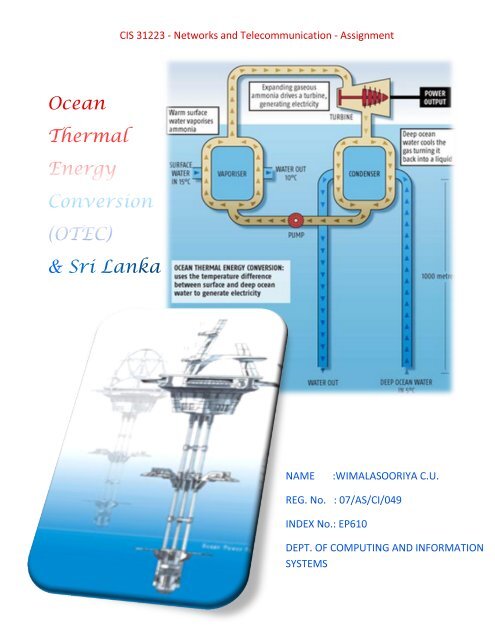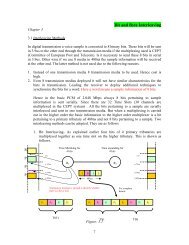Ocean Thermal Energy Conversion - Christiealwis.com
Ocean Thermal Energy Conversion - Christiealwis.com
Ocean Thermal Energy Conversion - Christiealwis.com
Create successful ePaper yourself
Turn your PDF publications into a flip-book with our unique Google optimized e-Paper software.
o<br />
ceans, the principal <strong>com</strong>ponent of the earth’s hydrosphere, covers approximately 71% of<br />
the Earth’s surface, making them the world’s largest recipient of solar energy. Each day,<br />
the oceans absorb enough heat from the Sun to equal the thermal energy contained in 250<br />
billion barrels of oil. Most of this energy is absorbed by oceanic bodies in the tropical belt.<br />
As Sri Lanka is an island nation well within the tropical belt having claims to an Exclusive<br />
Economic Zone (EEZ) 27 times the country’s land area and deprived of any exploited indigenous<br />
petroleum resource, if we can extract a portion of this energy, it will greatly improve our energy<br />
independence and energy security.<br />
<strong>Ocean</strong> <strong>Thermal</strong> <strong>Energy</strong> <strong>Conversion</strong> Systems (OTEC) is an emerging power generation<br />
method which converts this thermal energy into electricity.<br />
Ministry of power and energy of the government of Sri Lanka in its policy has mentioned<br />
that it is targeting a carbon neutral economy by 2020 1 .<br />
As a part of this drive, the government is considering OTEC or ocean thermal energy<br />
conversion power plant, in the deep-water harbour of Trin<strong>com</strong>alee 2 .<br />
What is OTEC ?<br />
<strong>Ocean</strong> thermal energy conversion (OTEC) uses the difference between cooler deep and warmer<br />
shallow or surface ocean waters to run a heat engine and produce useful work, usually in the form of<br />
electricity.<br />
The most <strong>com</strong>monly used heat cycle for OTEC is the Organic Rankine cycle using a low-pressure<br />
turbine. This will be a closed cycle operation. In simple terms it operates the same as an ordinary steam<br />
turbine found in a coal power plant. Yet as the temperature different in which this plant operates is very
low (around 20 0 C) steam cannot be used as the working fluid in the turbine. Therefore an organic<br />
<strong>com</strong>pound with a low boiling point is used as the working fluid.<br />
A basic closed-cycle OTEC plant is shown in the figure above. Warm seawater passes through an<br />
evaporator and vaporizes the working fluid, an organic substance such as ammonia, propane, refrigerant<br />
gases etc. This vapour which is at a higher temperature and pressure is fed into the turbine. The vapor<br />
expands as it passes through a turbine which turns a generator making electricity. The lower pressure<br />
vapor leaves the turbine and condenses in the condenser connected to a flow of cold seawater pumped<br />
from the deep ocean bed. The liquid ammonia leaves the condenser and is pumped to the evaporator to<br />
repeat the cycle.<br />
OTEC has long been challenged by high capital costs in a world of cheap energy. Recently,<br />
however, higher electricity costs, increased concerns for global warming, and a political <strong>com</strong>mitment to<br />
energy security have made initial OTEC <strong>com</strong>mercialization economically attractive in tropical island<br />
<strong>com</strong>munities such as ours where a high percentage of electricity production is oil based.<br />
Why is it important for us?<br />
Interest regarding OTEC power plants emerged in Sri Lanka in early 80’s. At a request of<br />
His Excellency the President, the Solar <strong>Energy</strong> Group of the National Science council carried out<br />
a feasibility study on ocean thermal energy conversion in Sri Lanka 3 . Yet due to the economic<br />
situation and unrest prevailed in the country during last few decades these projects did not go<br />
beyond the feasibility study level.<br />
Now with the push from the government policy decisions regarding renewable energy,<br />
energy security and carbon neutrality, OTEC has again showing signs of future dominance in Sri<br />
Lanka energy sector.<br />
There are several key factors behind this drive…..<br />
<br />
Need of an indigenous energy source.<br />
The hydro power potential of our country is almost fully exploited. And now the country is<br />
heavily depended on imported fossil fuel for its growing energy demand. Which has an adverse<br />
effect on the countries energy security and economic. OTEC power plants can operate as base<br />
load power plants. Which means it can generate a decided amount of power through-out the<br />
required time period. Thus they will be a candidate to replace fossil fuel fried base load power<br />
plants. Thus saving a large amount of foreign reserves of our country.<br />
<br />
Readily available resource<br />
In Sri Lankan territorial waters average temperature of surface sea water is around 25 0 C.<br />
At a depth of around 1000 m, the temperature goes down to about 5 0 C. Therefore a<br />
temperature gradient of about 20 0 C is there to be exploited for an OTEC project.
Also the continental Slope from continental shelf ends with a very high gradient is only<br />
several miles off shore in most parts of the island. Specially it is nearest to land in places such as<br />
Kalpitiya, Panadura, Deundara and Trin<strong>com</strong>alee. Therefore a higher temperature gradient can<br />
be achieved at a very short distance.<br />
As such the viability of OTEC as an energy source in Sri Lanka is truly great.<br />
<br />
Clean <strong>Energy</strong><br />
OTEC is a 100% clean energy source with zero emission in green-house gases.<br />
Where to begin?<br />
The Minister of power & energy mention in November 2010 that Sri Lanka will construct<br />
its first OTEC power plant around Trin<strong>com</strong>alee 2 . As Sri Lanka has no prior experience of offshore<br />
installation, building a shore based OTEC power plant as the first OTEC power plant will<br />
be the most suitable path. Shore base power plant is less in <strong>com</strong>plexity and also in operational<br />
cost.<br />
Panadura is situated close to the capitol of Colombo and within 3 km from the coast<br />
reaches a depth of 1500 m where the temperature difference is 20 0 C. Dondra canyon, located<br />
in the southern part of the island, is a valuable place for an OTEC plant because the necessary<br />
temperature difference is within 20km from the coast 4 .<br />
Top: conceptual drawing of an on-shore OTEC<br />
facility<br />
Left: bathymetric chart of Trin<strong>com</strong>alee Canyon
Under the natural harbour of Trin<strong>com</strong>alee runs extraordinarily deep under water canyon<br />
known as Trin<strong>com</strong>alee Canyon as shown in the bathymetric chart below 3 . The very steep<br />
canyon of Trin<strong>com</strong>alee is the most attractive and is called one of the most suitable sites for<br />
OTEC in the world. This canyon attains a depth of 1500 m only 1.5km from the coast<br />
Experiments done by research vessels, German R/V SONNE in 1994 and Sri Lankan R/V Samudra<br />
Maru found that the temperature difference in Trin<strong>com</strong>alee canyon is around 21 0 C 4 . Thus<br />
Trin<strong>com</strong>alee is an ideal place to build an experimental on-shore OTEC power plant.<br />
Future it holds………..<br />
With the maturing OTEC technology and building up local expertise we can venture in to<br />
off-shore mega scale OTEC power plants which will generate a considerable portion of the<br />
counties energy demand.<br />
Also these OTEC facilities can be used to generate hydrogen, the future fuel for vehicles.<br />
Provide coastal cities with fresh water distilled from the sea. This technology can be used for air<br />
conditioning and refrigeration purposes.<br />
As renewable energy technologies matures, we can set up energy islands in our territorial<br />
waters, which will <strong>com</strong>bine several renewable energy technologies such as OTEC, wind, tidal<br />
power, solar thermal etc.. These energy islands will generate electricity for our households and<br />
industries and hydrogen for fuel-cell driven vehicles to meet our transportation needs.<br />
Conceptual Drawings of <strong>Energy</strong> Islands
Referance:<br />
1. Ministry of Power & <strong>Energy</strong>: National <strong>Energy</strong> Policy and Strategies of Sri Lanka, 2006<br />
2. Lanka Business on-line ; Sri Lanka mulls ocean thermal energy option, 13/11/2010<br />
3. Dr. P.D.C. Wijayathuga, former Professor of Electrical Engineering, Department of Electrical Engineering, University of<br />
Moratuwa; <strong>Energy</strong> Supply, Demand and Research; Journal of the National Science Foundation of Sri Lanka 1999 27(1): 65-71<br />
4. Dr. T. K. D. Tennakoon, <strong>Ocean</strong>ography Division, National Aquatic Resources Agency (NARA); Prospects for the OTEC Plant at<br />
Sri Lankan Coastline, International OTEC/DOWA Association (IOA) newsletter, Vol. 4, No. 6/winter 1995<br />
On line Resources used :<br />
Lockheed Martin Corporation: 10 MW OTEC power plant<br />
http://www.lockheedmartin.<strong>com</strong>/products/OTEC/<br />
Lockheed Martin Videos : <strong>Ocean</strong> <strong>Thermal</strong> <strong>Energy</strong> <strong>Conversion</strong> (OTEC)<br />
http://www.youtube.<strong>com</strong>/watch?v=bSFp6WXyOU4&feature=related













